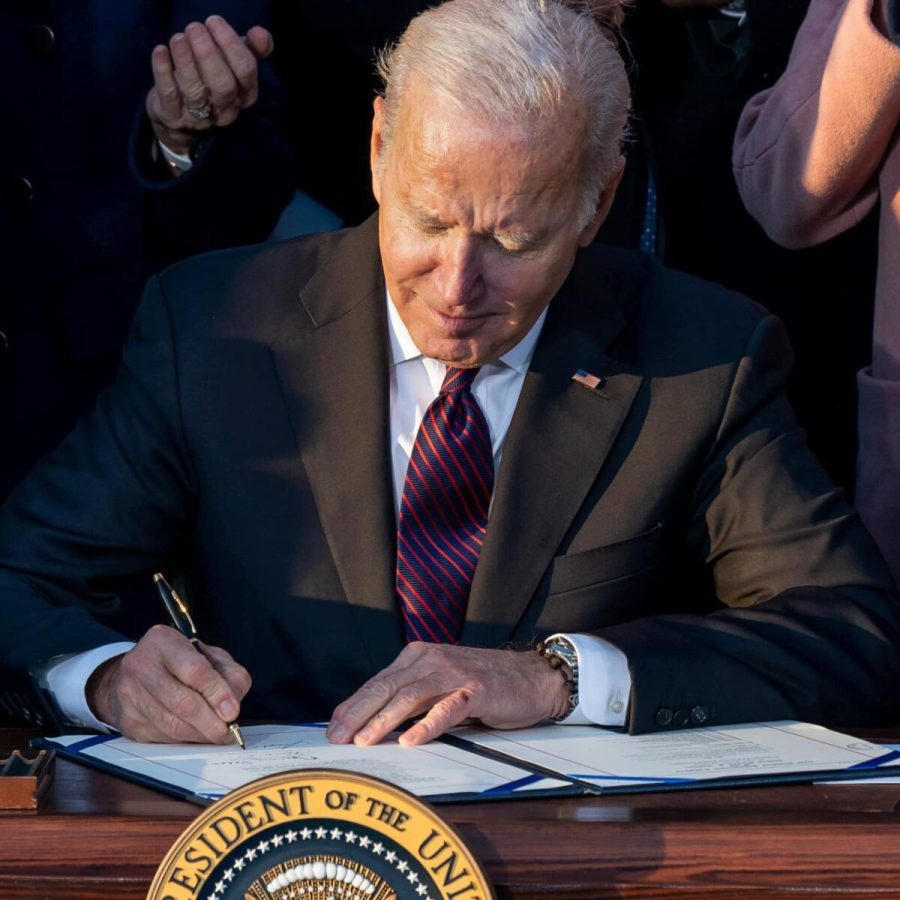Biden concludes first year of presidency
On January 20, 2021, Joe Biden was inaugurated into office as the 46th president of the United States.
Entering into office, Biden had a list of issues that he intended to begin working on during his presidency. Within the first 100 days in office, Biden took action on issues such a minimum wage, climate change, and immigration.
According to the Office of Personal Management, the Biden-Harris administration raised the federal minimum wage to $15 an hour for federal employees. Federal employees include some health care workers, law enforcement, and politicians.
Sarah Zimmerman (10, she/her) said that raising the minimum wage for non-federal employees is important to her. “A lot of people might not have the chance to go to college… and will be forced to work a minimum wage job, but if it’s so little, they can’t make a living,” she said.
On Biden’s first day in office, America rejoined the World Health Organization (WHO). WHO is a branch of the United Nations (UN) that, according to WHO’s website, is “dedicated to the well-being of all people.”
In July of 2020, then-president Donald Trump sent a letter to the UN declaring that the United States would withdraw from WHO.
On his first day in office, Biden had also reversed 15 of Trump’s executive orders. By doing so, he halted the building of the U.S-Mexico border wall, rejoined the Paris Climate Agreement and rejected Trump’s proposal to exclude non-American citizens in the U.S. census.
According to the White House’s fact sheet regarding the Leaders Summit on Climate, after rejoining the Paris Climate Agreement, Biden hosted a conference with 40 world leaders. Here, he promised that by 2030 America will reduce its emissions by 50 to 52 percent from 2005 emission levels.
On February 2, 2021, the President released an executive order that condemned the separation of families seeking to enter the United States. It was outlined that the Task Force would work to reunite families who were separated at the U.S.-Mexico border between January 20, 2017 and January 20, 2021.
Families would also be provided appropriate supplemental services relating to mental health and trauma. There has been no specific data released from the White House about the status of this program.
According to a progress report from November 29, 2021 released by the Department of Homeland Security, there were 3,951 identified children separated from their guardians between January of 2017 and January of 2021.
As of the release of this document, Homeland Security reports that 2,248 children have been reunited with their parents with 1,703 children who have not been returned to their parents. 206 children are in the process of being reunited with their families.
Another notable action took place on March 22, 2020, when Biden tweeted that at least $10,000 in student loan debts should be forgiven per person.
In order to do this, Biden took control of existing loan-forgiveness programs in order to improve them.
For example, people with student loans who have “total and permanent disabilities” have been eligible for loan forgiveness for years.
Recently, there has been an increase in the number of students who have received forgiveness through this program. Prior to 2021, about 0.3% of eligible applicants had their debt forgiven. According to a document from the U.S. Department of Education, as of August 19, 2021 more than 323,000 student loan borrowers that fit the criteria for Total and Permanent Disability discharges were going to receive over $5 billion in forgiveness.
“What he’s done so far with student loans is amazing, especially because the pandemic has put a stop on student loans [forgiveness] for a while,” Rhiannon Blase (11, she/they) said.
President Biden has paused student loan repayments through May 1, 2022. On December 21, 2021 in a statement released from the White House, Biden said, “…my Administration is extending the pause on federal student loan repayments for an additional 90 days…we manage the ongoing pandemic and further strengthen our economic recovery.”
Biden has not yet achieved the $10,000 debt relief objective.
“It’s hard because Congress hasn’t acted. I think it requires more than just him. I think Congress needs to do something about it,” Justin Rubenstein (10, he/him) said.
In August, the President decided to remove all U.S. troops from Afghanistan and evacuated hundreds of thousands of people from the country. Some of the first people to be evacuated were Americans and any allies in Afghanistan who aided American efforts in the war. Afghans vulnerable to violence or attacks were also prioritized in the evacuation.
“I know it’s an endless war… but I think we weren’t supposed to pull out…There were service members and they had an accidental strike – it was very chaotic. Their Afghanistan evacuation didn’t even get everyone out, which is terrible,” Rubenstein said.
In a remark given by President Biden on August 31, 2021 on his decision to remove U.S. presence from Afghanistan, he said, “We succeeded in what we set out to do in Afghanistan over a decade ago. Then we stayed for another decade. It was time to end this war.”
“I think the distinction between the war itself being over versus the effects of it is so important… We might be out of Afghanistan, but there’s so many after effects,” commented Blase.

